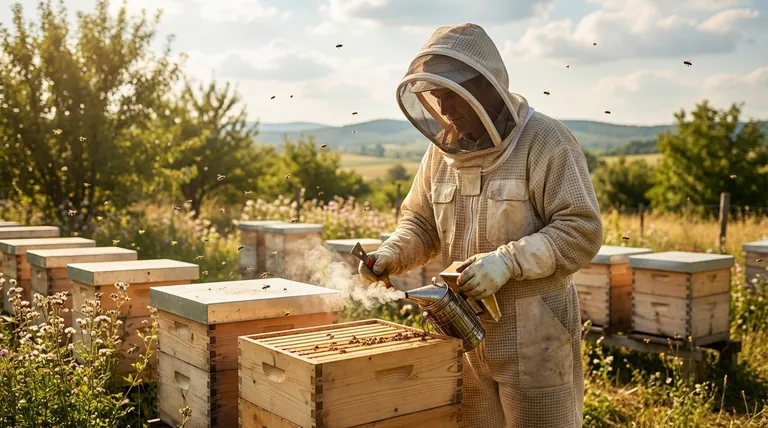Fundamentally, a beekeeping suit serves one primary purpose: to create a comprehensive physical barrier that protects you from bee stings. This protection allows a beekeeper to work calmly and safely within close proximity to a hive, performing necessary inspections and maintenance without fear of injury.
While sting prevention is the obvious function, the true purpose of a proper suit is to enable a calm, confident, and effective interaction with your hives. The right gear mitigates personal risk, allowing you to focus on the health of the colony rather than a fear of being stung.

Beyond Sting Prevention: The Core Functions
A high-quality beekeeping suit offers more than just a simple shield. It is a specialized tool designed to manage the entire environment of a hive inspection.
Creating a Sealed Barrier
The most critical function is to leave no exposed skin. A full suit, combined with gloves and a veil, creates a continuous layer of protection. Elastic seals at the wrists and ankles are vital for preventing determined bees from crawling inside the suit, which is a primary entry point.
Boosting Beekeeper Confidence
For new beekeepers, the psychological benefit of a suit is immense. The fear of being stung can cause jerky, sudden movements that bees perceive as a threat. A full suit provides the confidence needed to move slowly and deliberately, leading to a calmer hive and a safer experience for both the beekeeper and the bees.
Protecting Against the Elements
Beyond bees, a suit shields your skin from direct sun exposure during long inspections on hot days. It also keeps your regular clothing clean from sticky propolis and honey, which can be difficult to wash out.
Shielding from Other Insects
Apiaries can attract other stinging insects, such as yellow jackets or hornets, which are often more aggressive than honeybees. A beekeeping suit provides reliable protection from these insects as well.
Anatomy of a Modern Beekeeping Suit
A suit is a system of integrated components. Understanding each part helps clarify its importance.
The Full-Body Jumpsuit
This is the core of the suit, typically a one-piece coverall that runs from your neck to your ankles. It is designed to be loose-fitting, which keeps the fabric away from your skin and makes it harder for a bee's stinger to reach you.
The Integrated Hood and Veil
The veil is the most essential part for safety, protecting your face, eyes, and neck where stings are most dangerous and painful. Modern suits almost always feature a hood and veil that zip directly onto the jumpsuit, eliminating any gaps.
Gloves and Footwear
While not always sold with the suit, gloves and closed-toed boots complete the protective system. Gloves protect your hands, and tucking your suit's ankle cuffs into your boots ensures a final, secure seal at your feet.
Understanding the Trade-offs
Not all suits are created equal. The primary choice you will make is between a standard, solid-fabric suit and a modern ventilated one.
The Standard Suit: Maximum Protection, Minimal Breathability
Traditional beekeeping suits are made of a thick cotton or poly-cotton blend. They offer excellent protection and are often less expensive. Their major drawback is a lack of ventilation, which can cause the beekeeper to become dangerously overheated in hot, humid climates.
The Ventilated Suit: Balancing Comfort and Safety
Ventilated suits are constructed from multiple layers of mesh fabric. This design allows air to flow freely through the suit, keeping you significantly cooler while the layers are thick enough to prevent stingers from reaching your skin. The primary trade-off is that these suits are typically heavier and more expensive.
The Risk of Perceived Invincibility
Regardless of the type, a suit can sometimes lead to overconfidence. It is critical to remember that a suit reduces risk; it does not eliminate it. Careless handling can still agitate a colony, and poor maintenance can result in tears or unzipped sections that create an opening for bees. Always pair your suit with calm behavior and a smoker.
Making the Right Choice for Your Goal
Selecting a suit depends on your climate, experience level, and personal comfort with bees.
- If your primary focus is maximum confidence as a new beekeeper: A standard, full-body suit offers the best psychological and physical barrier, allowing you to learn without fear.
- If your primary focus is comfort in a hot climate: Investing in a fully ventilated suit is essential for preventing heat exhaustion during summer hive inspections.
- If your primary focus is managing multiple aggressive hives: The full-body protection of a jumpsuit is non-negotiable, and a ventilated model will improve your endurance.
Ultimately, your beekeeping suit is the key that unlocks a safe and productive relationship with your bees.
Summary Table:
| Function | Key Feature | Benefit |
|---|---|---|
| Sting Prevention | Full-body, sealed barrier | Protects skin from bee stings |
| Beekeeper Confidence | Complete coverage | Enables calm, deliberate movements |
| Environmental Protection | Durable fabric | Shields from sun, propolis, and honey |
| Ventilation & Comfort | Mesh layers (ventilated suits) | Prevents overheating in hot climates |
Ready to work with your hives confidently and safely?
A high-quality beekeeping suit is fundamental for protecting commercial apiaries and distributors. HONESTBEE supplies durable, professional-grade beekeeping suits and equipment designed for the demands of wholesale operations.
Contact HONESTBEE today to discuss your protective gear needs and ensure the safety and productivity of your beekeeping business.
Visual Guide

Related Products
- Wholesales Dadant Size Wooden Bee Hives for Beekeeping
- Professional Insulated Plastic Bee Hives
- Long Langstroth Style Horizontal Top Bar Hive for Wholesale
- Automatic Honey Flow Beehive 4 Frame Mini Hive for Beekeeping
- Professional Insulated Winter Hive Wrap for Beekeeping
People Also Ask
- What are the essential pieces of equipment for most beekeepers? Get Started with the Right Gear
- What is beekeeping equipment? Essential Tools for Commercial Apiaries & Distributors
- What is the best place to keep bees? Find the Perfect Apiary Site for Your Hives
- Why were wooden hives traditionally preferred? For Natural Beekeeping Aligned with Bee Biology
- How often should the area under beehives be inspected and cleaned during the warm season? A Proactive Maintenance Guide



















